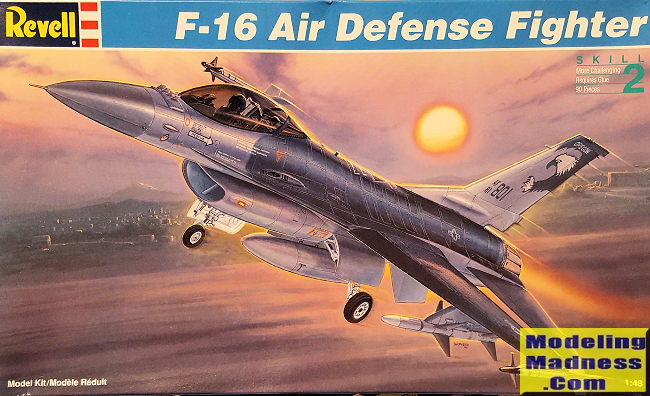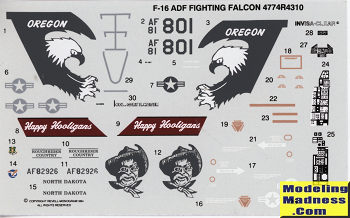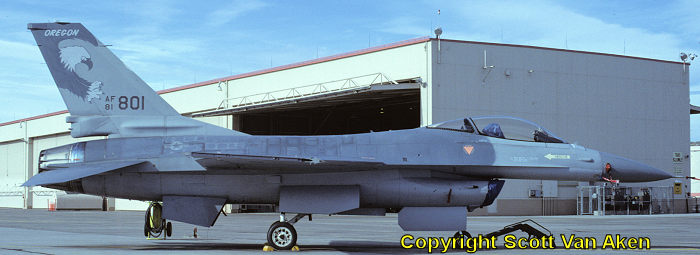
Revell 1/48 F-16 Air Defense Fighter
| KIT #: | 4774 |
| PRICE: | $10.50 |
| DECALS: | Two options |
| REVIEWER: | Scott Van Aken |
| NOTES: | 1994 Release |

| HISTORY |
The F-16 ADF can be distinguished from "standard" F-16A/B's by several external identifying features, such as long and thin horizontal bulges on the base of the vertical tail (only A-models), plus a set of four blade antenna, nicknamed "bird-slicer", carried just forward of the canopy and on the underside of the intake (as part of the IFF system).
The bulges are caused by the relocation of the Bendix-King AN/ARC-200 high frequency single-sideband radio to the leading edge of the fin. This in turn caused the flight control accumulators, which were installed one over the other, to be relocated to either side of the tail fin. The bulges were installed to provide sufficient room for these accumulators. Note that, since the Bravo-model ADF's do not have the Bendix HF radio, they also don't have the bulges. In addition, a 150,000 candlepower night identification spotlight was installed on the port side of the nose below and in front of the cockpit to aid in the identification of nighttime intruders.
All ADF F-16s are modified airframes. Existing Block 15 models where converted to the Block 15OCU upgrade and to ADF standard at once. In total, 271 airframes, consisting in 246 A-models and 25 B-models have been converted between 1989 and 1992. Minor differences exist between the A-model and B-model as described earlier.
Because of the fall of the Berlin wall in 1989 and the opening of relationships between West and East, the program had lost its major reason of existence, being the protection of the North American continent against Russian bombers flying over the North Pole. Although the program was finished and all aircraft stayed into service with the Air National Guard detachments, they were the first to be mothballed at AMARC with the first major restructuration of the USAF. This process started already in 1994. Two ANG units, the 169th and 198th FS flew this version in the ground attack role.
A lot of these ADF F-16s became a very cheap and quite modern asset for allied countries. These aircraft have relatively low flying hours on their airframes. A lot of them are sold on the second-hand market. Jordan was the first to receive 12 A-models and 4-models under the Peace Falcon program in 1997. Recently, Thailand has acquired another batch of 15 A-models and 1 B-model under the Peace Naresuan IV program. Also the Italian Air Force received 26 A-models and 4 B-models 10 years lease agreement called Peace Caesar which ended in 2012.
| THE KIT |
According to Scalemates, this kit is simply a modification of Revell's 1980 F-16 kit. The tooling isn't new even for 1994 as there are some fairly substantial areas of flash on the sprues. Fortunately, this does not impact the actual parts all that much. The exterior detailing is a mixture of raised and engraved panel lines with the engraved lines being fairly soft with rounded edges. The wings in particular have a peculiar raised pattern made up of rows of rectangles.
The cockpit is adequate for a 40+ year old kit with an acceptable bang seat and a tub that has zero detail on the side consoles. Same for the instrument panel. You are supplied with decals for these areas. The cockpit tub and a rear bulkhead fit into the upper fuselage half to be trapped with the lower section. Note that the wings are molded in with the fuselage halves. One will need to open the holes for the Sparrow pylons before attaching these halves. There are no wing mounted drop tanks provided. Note that the burner section is now installed. It is not very deep, but adequate.
The intake halves incorporate part of the fuselage along the side of the wheel wells. There is an intake insert to be installed prior to attaching the forward section of the intake. This is then installed on the lower fuselage. Attention is now turned to main gear wells, which are lacking is all but very basic detail. The forward well bulkhead is installed and later the center section and the rear well bulkhead, which includes the main gear, is glued in place.
The wing tip Sidewinder mounts include a small section of the outer wing to be sure you get them in place. You have the option of either a Sidewinder or a target designator to place on these mounts. Once the nose gear and main gear are assembled and installed, the gear doors and other small bits are attached. In the back the horizontal stabs and the fin/rudder pieces are slotted in place. Finally, the smaller bits, the centerline tank, Sparrow pylons and missiles are glued in place. The canopy is a single piece and is fairly clear.
 Instructions
are well done and quite typical of Revell-Monogram instructions with parts named
and colors provided. The two options are the box art plane of the 114 FS, Oregon
ANG, the training squadron for the ADF, as well as the 178 FS, North Dakota ANG.
Both planes are in the three greys scheme. Decals are nicely done and should
provide no issues. Below is a photo of 801 that I took at Klamath Falls back in
1991. This plane was later supplied to the Italian Air Force.
Instructions
are well done and quite typical of Revell-Monogram instructions with parts named
and colors provided. The two options are the box art plane of the 114 FS, Oregon
ANG, the training squadron for the ADF, as well as the 178 FS, North Dakota ANG.
Both planes are in the three greys scheme. Decals are nicely done and should
provide no issues. Below is a photo of 801 that I took at Klamath Falls back in
1991. This plane was later supplied to the Italian Air Force.

| CONCLUSIONS |
So why should you seek this one out as it clearly is not an up-to-date offering? Well, it has the benefit of being an ADF variant right out of the box without having to resort to resin bits to make the update. It isn't the best F-16 kit in this scale by any stretch, and you'll want to sand off all the rectangles on the wings as those just look odd. But it can often be found for a very reasonable price and unless you are ultra-anal or building for contests, it will look good on your display shelf when done.
July 2021
Copyright ModelingMadness.com. All rights reserved. No reproduction in
part or in whole without express permission.
Review kit courtesy of my wallet If you would like your product reviewed fairly and fairly quickly, please contact the editor
or see other details in the
Note to
Contributors. Back to the Main Page
Back to the Review
Index Page
Back to the Previews Index Page